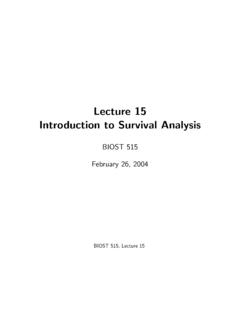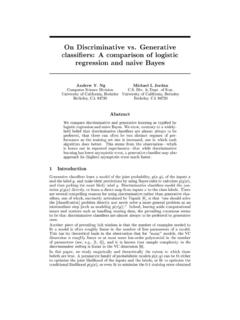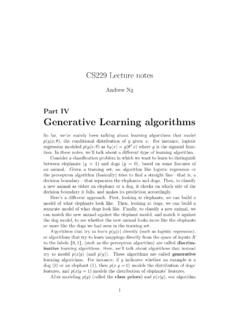Transcription of NLREG
1 NLREG Nonlinear regression analysis Program Phillip H. Sherrod Copyright 1991 2010 All rights reserved NLREG performs statistical regression analysis to estimate the values of parameters for linear, multivariate, polynomial, logistic, exponential, and general nonlinear functions. The regression analysis determines the values of the parameters that cause the function to best fit the observed data that you provide. This process is also called curve fitting. NLREG allows you to specify the function whose parameters are being estimated using ordinary algebraic notation. In addition to determining the parameter estimates, NLREG can be directed to generate an output file with predicted values and residuals.
2 It can also plot the data observations and the computed function. Although designed for regression analysis , NLREG can also be used to find the root (zero point) or minimum absolute value of a nonlinear expression. NLREG is in use at hundreds of engineering and research centers around the world. 1 Contents Introduction ..5 Introduction to regression analysis .. 5 Introduction to 6 Versions of NLREG .. 8 Installing NLREG .. 9 Using 11 Running NLREG .. 11 Performing an analysis .. 11 Viewing the Results and Plots .. 12 Evaluating the Function at Specific Points .. 12 Statement Syntax .. 14 Variables and Parameters .. 14 Plots .. 15 Overview of Computation Process .. 19 Function Specification.
3 20 Numeric Constants .. 21 Symbolic Constants .. 21 Built-in Constant .. 22 Built-in Functions .. 22 NLREG Program Files ..29 Comments .. 29 Required Statements .. 29 NLREG Program Statements .. 30 30 VARIABLES .. 30 PARAMETERS .. 30 DOUBLE .. 31 CONSTANT .. 32 CONSTRAIN .. 32 SWEEP .. 33 FUNCTION .. 34 CORRELATE .. 34 COVARIANCE .. 34 CONFIDENCE .. 34 TOLERANCE .. 35 ITERATIONS .. 35 OUTPUT .. 35 POUTPUT .. 36 PLOT .. 36 CONTOURPLOT .. 41 SPLOT .. 42 RPLOT .. 44 NPLOT .. 47 2 Assignment Statement .. 48 IF Statement .. 48 WHILE Statement .. 49 DO Statement .. 49 FOR Statement .. 50 BREAK Statement .. 50 CONTINUE Statement .. 51 STOP Statement .. 51 BADSTEP Statement .. 51 DATACOUNT statement .. 51 DATASKIP 52 DATA .. 52 Setting Colors and Saving Plots.
4 55 Selecting Colors for 55 Saving Plots to Disk Files .. 56 Understanding the Results ..57 Descriptive Statistics for 57 Parameter Estimates .. 57 t Statistic .. 57 Prob(t) .. 57 Final Sum of Squared Deviations .. 58 Average and Maximum Deviation .. 58 Proportion of Variance Explained .. 58 Adjusted Coefficient of Multiple Determination .. 59 Standard Error .. 59 Durbin-Watson Statistic .. 59 analysis of Variance Table .. 60 F Value and Prob(F) .. 60 Correlation Matrix .. 61 Theory of Operation ..63 Minimization 63 Convergence Criterion .. 63 Hints for NLREG Use ..65 Convergence Failures .. 65 Singular Matrix Problems .. 66 Performance 66 Program Limits .. 66 Example Special Applications ..73 Fitting the Integral of a Function.
5 73 Omitted Dependent Variable .. 74 Root Finding and Expression Minimization .. 76 Function Minimization Examples .. 77 3 Command-line Version of DLL and COM Version of NLREG ..80 Acknowledgement and Use of NLREG ..83 83 Use and Distribution of NLREG .. 83 Copyright Notice .. 83 Disclaimer .. 83 DTREG Decision Tree Generation Program ..85 Index ..87 5 Introduction Introduction to regression analysis The goal of regression analysis is to determine the values of parameters for a function that cause the function to best fit a set of data observations that you provide. In linear regression , the function is a linear (straight-line) equation. For example, if we assume the value of an automobile decreases by a constant amount each year after its purchase, and for each mile it is driven, the following linear function would predict its value (the dependent variable on the left side of the equal sign) as a function of the two independent variables which are age and miles: value = price + depage*age + depmiles*miles where value, the dependent variable, is the value of the car, age is the age of the car, and miles is the number of miles that the car has been driven.
6 The regression analysis performed by NLREG will determine the best values of the three parameters, price, the estimated value when age is 0 ( , when the car was new), depage, the depreciation that takes place each year, and depmiles, the depreciation for each mile driven. The values of depage and depmiles will be negative because the car loses value as age and miles increase. For an analysis such as this car depreciation example, you must provide a data file containing the values of the dependent and independent variables for a set of observations. In this example each observation data record would contain three numbers: value, age, and miles, collected from used car ads for the same model car. The more observations you provide, the more accurate will be the estimate of the parameters.
7 The NLREG statements to perform this regression are shown below: Variables value,age,miles; Parameters price,depage,depmiles; Function value = price + depage*age + depmiles*miles; Data; {data values go here} Once the values of the parameters are determined by NLREG , you can use the formula to predict the value of a car based on its age and miles driven. For example, if NLREG computed a value of 16000 for price, -1000 for depage, and for depmiles, then the function value = 16000 1000*age *miles could be used to estimate the value of a car with a known age and number of miles. If a perfect fit existed between the function and the actual data, the actual value of each car in your data file would exactly equal the predicted value.
8 Typically, however, this is not the case, and the difference between the actual value of the dependent variable and its predicted value for a particular observation is the error of the estimate which is known as the "deviation or "residual . The goal of regression analysis is to determine the values of the parameters that minimize the sum of the squared residual values for the set of observations. This is known as a "least squares regression fit. 6 Introduction to NLREG NLREG is a very powerful regression analysis program. Using it you can perform multivariate, linear, polynomial, exponential, logistic, and general nonlinear regression . What this means is that you specify the form of the function to be fitted to the data, and the function may include nonlinear terms such as variables raised to powers and library functions such as log, exponential, sine, etc.
9 For complex analyses, NLREG allows you to specify function models using conditional statements (IF, ELSE), looping (FOR, DO, WHILE), work variables, and arrays. NLREG uses a state-of-the-art regression algorithm that works as well, or better, than any you are likely to find in any other commercial statistical packages. As an example of nonlinear regression , consider another depreciation problem. The value of a used airplane decreases for each year of its age. Assuming the value of a plane falls by the same amount each year, a linear function relating value to age is: value = p0 + p1*Age Where p0 and p1 are the parameters whose values are to be determined. However, it is a well-known fact that planes (and automobiles) lose more value the first year than the second, and more the second than the third, etc.
10 This means that a linear (straight-line) function cannot accurately model this situation. A better, nonlinear, function is: value = p0 + p1*exp(-p2*Age) Where the 'exp' function is the value of e ( ) raised to a power. This type of function is known as "negative exponential and is appropriate for modeling a value whose rate of decrease is proportional to the difference between the value and some base value. The example program file fits a linear function to the value of used airplanes. The example fits a negative exponential function to the same data. Run both examples and compare the fitted functions. See for an example of multiple regression using three independent variables.





